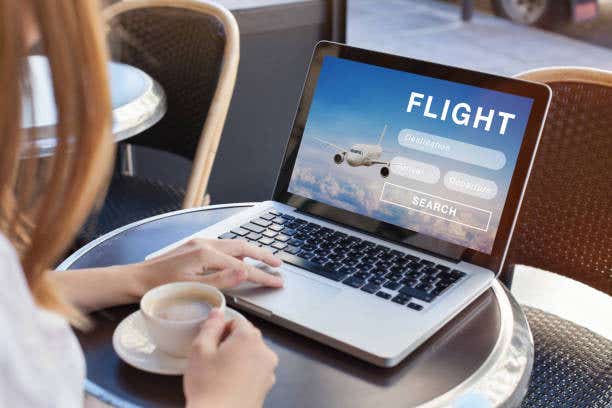Surprising research shows how airline pricing really works
Researchers debunk popular myths about snagging cheaper airfares and shed light on the intricate logic airlines use to set ticket prices.

[Oct. 22, 2023: Staff Writer, The Brighter Side of News]
Researchers debunk popular myths about snagging cheaper airfares and shed light on the intricate logic airlines use to set ticket prices. (CREDIT: iStock photo)
In a world increasingly dominated by digital algorithms and seemingly inscrutable pricing structures, securing the cheapest airline ticket can feel like an arcane quest.
Consumers are inundated with tips and so-called hacks purporting to unlock the secrets to cheaper flights — buy on a Tuesday, use your browser's incognito mode, or even use a VPN to feign residency in countries like Suriname. However, recent insights from a team of esteemed researchers suggest that many of these strategies are based on misconceptions.
“There are so many hacks out there for finding cheaper airline tickets,” asserts Olivia Natan, an assistant professor of marketing at the Haas School of Business. “But our data shows many of these beliefs are wrong.”
Natan's revelations stem from an in-depth study she conducted with colleagues Ali Hortaçsu and Timothy Schwieg from the University of Chicago, Kevin Williams from Yale, and Hayden Parsley from the University of Texas at Austin. The team delved into the intricacies of how prices are established at a major U.S. airline, uncovering a system that defies not only the expectations of many economists but also the assumptions of everyday consumers.
Related Stories:
Their findings upend a lot of conventional wisdom about how airline pricing works, suggesting that the strategies airlines use in setting ticket prices are far more complex and less responsive to consumer-led demand shifts than previously thought.
“We initially didn’t know how to rationalize the things we were seeing,” Natan admits, reflecting on the team's journey into the airline's pricing structure, which, they discovered, represents common practices across global airlines.
The research highlighted how airlines price tickets in a way that seems to ignore basic economic principles of substitute goods and competition. Unlike shopping for fruit jam at a grocery store, where a price increase for strawberry jam might boost sales of raspberry jam as consumers opt for the cheaper alternative, airline pricing systems don't factor in such substitution effects.
Note: Image plot of fare availability over time as well as the active lowest available fare. Bucket1 is the least expensive; Bucket12 is the most expensive fare class. The color depicts the magnitude of prices—blue are lower fares, red are more expensive. White space denotes no fare availability. The white line depicts the lowest available fare. (CREDIT: UChicago)
“When people visit a website such as Google Flights or Kayak and search for a ticket, a wide range of different flights from the same airline appear. Travelers tend to make selections that balance convenience and price: The price of one flight might push people to select a slightly less convenient but cheaper flight,” Natan explains. “But the systems airlines use don’t consider this kind of substitution.” They price seats on each individual flight on a given route separately, disregarding the interplay between the pricing of different flights on the same route.
Furthermore, airlines surprisingly don't directly incorporate their competitors' prices into their automated price-setting mechanisms. This is counterintuitive because, in most industries, a price cut by one company typically triggers a domino effect of reductions among rivals to maintain competitive balance. The absence of this dynamic in airline pricing diminishes the consumer benefits that a competitive market usually offers.
Note: (a) The orange line denotes the average change in shadow value for a flight when a sale at a given intensity occurs. The blue line is the average change to shadow value when a sale occurs to another flight at a given intensity. (b) This panel depicts the same as panel a, but instead of changes in shadow value it depicts changes in price. (CREDIT: UChicago)
According to Natan, these pricing quirks arise from a specific heuristic airlines employ, known as Expected Marginal Seat Revenue-b (EMSRb). This approach, widely used due to its efficiency in handling the colossal task of setting prices for hundreds of thousands of flights daily, allows airlines to set aside some seats to sell at premium prices. However, it has its peculiarities.
One such peculiarity is the revelation that, contrary to what one might assume when browsing flights, airlines work with a pre-determined, relatively limited array of ticket prices for each flight. Instead of the highly granular, dynamic pricing seen in other sectors, airlines have substantial gaps — often around $100 — between each possible ticket price tier.
Note: The horizontal axis of all plots denotes the negative time index, e.g. zero corresponds to the last day before departure. (a) Normalized model fit of searches with data searches. (b) Model fit of product shares with empirical shares. (c) Fitted values of γt overtime, along with the probability a consumer is business conditional on purchase. (d) Mean product elasticities over time, along with the least and most elastic flights. (CREDIT: UChicago)
“Airline tickets are sold through global distribution systems that ensure a travel agent in Wichita or Miami sees the same price as you do on your computer at home,” Natan points out. This consistency results from an industry-wide system developed to streamline inventory management across various channels — a system also utilized by other travel-related businesses, including hotels, cruise lines, trains, and car rental companies.
However, this approach has drawbacks. For one, it renders airline ticket prices somewhat impervious to real-time shifts in demand, given the significant leap to the next price point. The research team noted that even when airlines intend to hike prices by $100 — which is roughly half the cost of an average one-way ticket — they only do so about 20% of the time due to the lack of a suitable intermediate fare.
Note: (a) Comparison of product shares across consumer types, over time. (b) Estimates of γt versus those calculated using the passenger assignment algorithm. (c) Forecasted demand across consumer types, over time. (d) Comparison of own-price elasticities over time. (b) and (d) contain the 25th and 75th percentiles. Results are reported averaging over all observations in the data. (CREDIT: UChicago)
Natan reveals that airlines are exploring “continuous revenue management,” a strategy that could assign 100 different prices to a flight with 100 seats, introducing more variability. “That would make pricing significantly more variable,” she says, “but even that would not be the kind of targeting that many consumers assume airlines use.”
The study unearthed more oddities in the airlines' internal pricing processes. Notably, there's a disconnection within the airlines' departments responsible for pricing. Economically, it would seem irrational for a company not to raise prices when assured of increased revenue. Yet, the set of potential prices selected by the pricing team frequently includes options that are inexplicably low, even by their own standards.
“The pricing team’s work is complicated by having to choose an entire menu of discrete prices, but we found they could make more money today by selling fewer tickets at higher prices and not foreclose future opportunities. In practice, they choose the menu of prices without using their internal demand predictions,” Natan elaborates.
Another layer of complexity is added by the revenue management team, which steps in after the prices are determined but before tickets are sold. They conduct demand forecasts, routinely inflated, that shape the final prices, reducing the number of underpriced tickets available to consumers by about 60%.
“These prices are a consequence of teams from different departments choosing the best pricing inputs when they are unable to coordinate,” Natan indicates. She believes this lack of coordination might result in lower revenues, but the alternatives aren't easily implementable. There are also other potential reasons airlines might shy away from strict profit maximization, including building customer loyalty or evading regulatory scrutiny.
Looking forward, Natan anticipates a gradual shift towards more dynamic pricing models in the airline industry, which could potentially benefit non-business travelers. However, the elusive "silver bullet" for discovering dramatically lower fares remains a fantasy. The practical advice she offers is deceptively simple: “What I can say is that prices do go up significantly 21, 14, and seven days before a flight. Just buy your ticket before then.”
While the quest for the cheapest airline tickets is fraught with myths and misinformation, understanding the underlying mechanisms at play can empower consumers to make more informed decisions. And as airlines evolve, keeping abreast of these changes will be crucial for travelers everywhere.
Note: Materials provided above by The Brighter Side of News. Content may be edited for style and length.
Like these kind of feel good stories? Get the Brighter Side of News' newsletter.
Joseph Shavit
Head Science News Writer | Communicating Innovation & Discovery
Based in Los Angeles, Joseph Shavit is an accomplished science journalist, head science news writer and co-founder at The Brighter Side of News, where he translates cutting-edge discoveries into compelling stories for a broad audience. With a strong background spanning science, business, product management, media leadership, and entrepreneurship, Joseph brings a unique perspective to science communication. His expertise allows him to uncover the intersection of technological advancements and market potential, shedding light on how groundbreaking research evolves into transformative products and industries.



